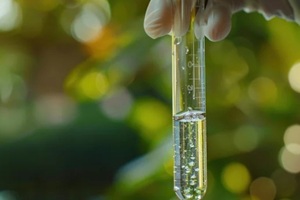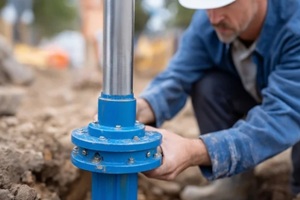
If your home or business relies on a private well, the quality of your water depends entirely on how well you maintain and test it. Without regular checkups, invisible contaminants like bacteria, nitrates, or naturally occurring minerals can go unnoticed, affecting both taste and safety.
Think of water testing as routine maintenance for your well: a simple annual test can reveal early signs of problems and help you make informed choices about treatment or repairs.
The Basics of Annual Well Water Testing
Private wells in Maryland operate outside the federal Safe Drinking Water Act, meaning the responsibility for testing and maintenance rests solely with the homeowner.
While the Maryland Department of the Environment (MDE) and local health agencies can advise on proper testing procedures and water safety, they do not conduct continuous supervision of private wells.
Agencies such as the Centers for Disease Control and Prevention (CDC) and the U.S. Environmental Protection Agency (EPA) recommend that homeowners schedule yearly water tests to measure total coliform bacteria, nitrates, pH balance, and total dissolved solids (TDS). These core tests identify common sanitary issues, track general water chemistry, and help detect early signs of contamination.
Alongside the annual test, MDE suggests adding tests based on your location and nearby land uses, such as farms, industrial sites, or older septic systems.
Local Conditions Shape What You Should Test
Maryland’s diverse geology plays a major role in determining which additional tests make sense for your property. Different aquifers and soil compositions influence the types of contaminants most likely to appear in groundwater.
Piedmont Uplands
In central and western Maryland, wells often draw from Piedmont aquifers, where elevated radon levels are common. Homeowners in these areas should consider testing their water for radon, especially if indoor air tests have already shown higher readings.
Coastal Plain
In counties such as Anne Arundel and surrounding areas, naturally occurring radium has been found in some groundwater formations, including the Magothy and Patapsco. A gross alpha screening or specific radium test can help detect these radionuclides.
Eastern Shore and Delmarva Peninsula
Shallow, sandy aquifers beneath agricultural zones are more susceptible to nitrate contamination from fertilizers and septic effluent. Annual nitrate testing is essential, and every few years, a broader panel that includes nutrients and metals provides a fuller picture of water quality.
Emerging Concern: PFAS
Per- and polyfluoroalkyl substances (PFAS) are gaining attention across Maryland. Studies from the U.S. Geological Survey and advisories from MDE show elevated risks near airports, military sites, and certain industrial areas. If you live near these locations, adding PFAS testing to your plan is a wise choice.
Local health departments often publish maps that highlight areas prone to issues such as radium, saltwater intrusion, or volatile organic compounds (VOCs). Checking these resources helps you select the appropriate tests for your specific setting.
Choosing a Certified Laboratory

Accurate testing starts with selecting a state-certified drinking water laboratory. Certification confirms that the lab meets quality standards for methods, detection limits, and handling procedures.
MDE provides a list of certified labs, and the University of Maryland Extension offers a homeowner-friendly directory of labs that accept private samples. Using a certified lab ensures that your results meet standards for real estate transactions, health decisions, and long-term recordkeeping.
How Sampling Works in Practice
The process begins with ordering the correct sample bottles from the laboratory. Bottles for microbiological tests are sterile and may include preservatives.
Because bacterial levels can change quickly, water samples taken for coliform testing need to be submitted to the lab within one day of collection. Collect samples from a clean, representative tap such as a kitchen faucet without aerators or hoses.
To achieve an accurate reading, open the faucet and let the water run until the line is completely flushed and fresh water from the well is flowing steadily. When testing for lead and copper, use a separate first-draw sample taken after water has been stagnant for several hours.
Samples should be kept cold and properly labeled with chain-of-custody documentation. Laboratories supply instructions, forms, and coolers to help maintain sample integrity. Following their directions protects data accuracy; for instance: microbes can die off if water warms, certain metals require acid preservation, and VOC samples must be free of air bubbles.
Public health agencies sometimes provide sampling services for a fee. Frederick County Health Department, for example, posts pricing for coliform, nitrate, and turbidity testing, which offers a useful comparison even if you choose a private lab.
Understanding and Acting on Your Results
Once you receive your results, compare them to the EPA’s Primary Maximum Contaminant Levels (MCLs) for health-based standards and Secondary Levels for aesthetic qualities such as taste or staining. Private wells are not regulated, but these benchmarks help guide next steps.
Some Maryland-specific insights can clarify the findings:
- Lead generally originates from household plumbing rather than the aquifer. Testing for lead alongside pH and alkalinity helps assess corrosivity and the need for corrosion control or fixture replacement.
- Radionuclides may appear as gross alpha activity, which signals whether to pursue further tests for radium or uranium.
- PFAS results are reported in parts per trillion. If detected, point-of-use treatment systems using certified adsorptive media or reverse osmosis can reduce levels; always re-test after treatment.
When results exceed health-based limits, treatment or alternative water sources should be considered, followed by re-testing to confirm improvement.
Keeping Your Maryland Well Water Safe and Reliable

Water quality is critical to both health and compliance, which is why we offer flexible testing packages to fit different needs. Our Conventional Water Test screens for bacteria, nitrates, nitrites, pH, and chlorine residual, while our USDA/FHA/VA Loan Test meets stringent program requirements by adding turbidity and lead to the panel. For homeowners looking for quick insights, we also provide a Courtesy Water Analysis that measures iron, hardness, and pH at no cost.
At Tri-County Pump Service, Inc., we’ve spent more than three decades helping Maryland, Virginia, and West Virginia homeowners care for their water from the wellhead to the tap. If it’s time for your annual well water test or you’d like professional guidance on interpreting results and choosing the right treatment, we’re here to help.
Call us at 1-(301)-783-0038, schedule a free water estimate online, or reach out through our contact form to get started with a team that understands your water needs from start to finish.



